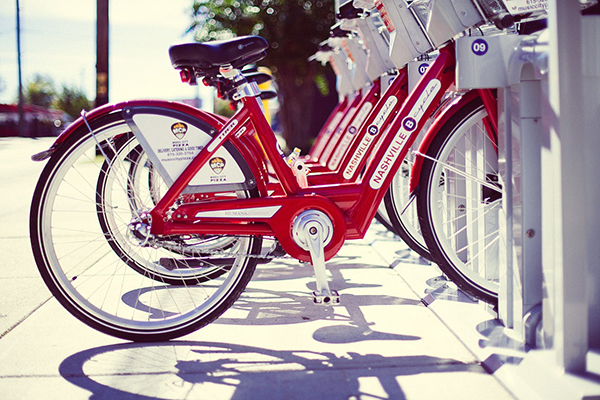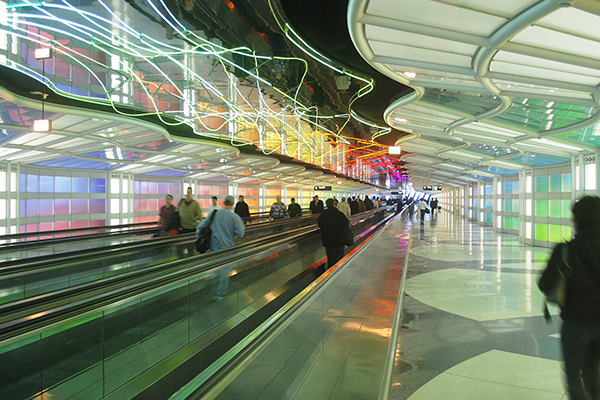
As populations explode, our cities and their residents urgently need the benefits of smart technology. Living in congested urban areas is made possible, and even pleasurable, but only when the infrastructure and design allow the technology to thrive.
People are finding novel ways to automate every part of the city, from better parking, smarter trash pickup and systems that warn drivers about oncoming pedestrians to apps that let residents participate in their city’s future development.
We’ve looked at 20 startups doing great work in the realm of smart cities. Some have been established for years and are global concerns; others are getting ready for their product launches. And all ultimately have the same goal: to make our cities better places to live.
Enevo
Co-founded by Finnish entrepreneur Fredrik Kekäläinen in 2010, Enevo provides wireless sensors for waste containers. These sensors measure fill-levels of both recyclable and solid waste materials. By collecting and analyzing data, collection schedules can be altered and routes optimized (demand-based schedules are more efficient and cheaper to run than fixed schedules).
Rose Dykins, writing for Norwegian Airlines’ magazine, says that the sensors sending fill-level data to Enevo’s system can remain in the bins for a decade. “We can analyse the data and come up with the best possible fleet and resources needed for the collection,” Kekäläinen tells Dykins. “Everything is automated — a truck driver simply logs into the system in their truck, and sees exactly which route to take that day.”
Headquartered in Finland, Enevo has offices in the US, UK, Germany, Hong Kong and Japan.
Bintelligence
Co-founder Alejandro Ricatti says his company, Bintelligence, is still in the process of obtaining funding for its launch, but that its product, a retrofittable solar-powered sensor with rechargeable batteries for waste bins, is ready and working.
Like Enevo, Bintelligence sensors measure the fill-rate of garbage bins, sending the data to system servers. The information allows trash collectors to schedule their routes more effectively and indicates areas where more bins may be needed.
Zerocycle
Reducing waste and significantly increasing recycling is Zerocycle’s goal. Using behavioral science and big data, the software company works with local governments, using a platform that highlights comparative neighborhood-level recycling data.
Then, the company sends this data to local homeowners, on behalf of the city, to encourage neighbors to try to out-recycle each other.
Co-founded in 2014 by Hunter Hayes, Richard Rothman and William Arnold, and headquartered in Washington, D.C., Zerocycle says this is the best way to effect change at the municipal level, especially in the face of recycling rates that haven’t really gone up in the past five-plus years.
Homer Logistics
This New York-based software company, founded by aerospace engineer turned entrepreneur Adam Price, makes life better for hungry city dwellers by getting them their food faster. Price created Homer Logistics to make hyperlocal delivery of small packages in dense, urban environments faster, calling it a sort of “UPS for smart cities.”
This delivery system for anything currently focuses solely on restaurants. They outsource their entire delivery service, and Homer Logistics provides the management software and delivery infrastructure for rapid, cost-effective delivery.
In a LinkedIn article, Price says the delivery space is massive and says there’s room to grow. Using advanced order assignment methods, Price’s delivery solutions are faster and cheaper than those provided by FedEx, Amazon or Postmates.

MuniRent
According to Alan Mond, co-founder and CEO of MuniRent, government heavy-duty equipment is idle about 70 percent of the time. The cost to California alone, he says, is nearly $17 billion in locked capital, and the problem of redundant fleets is repeated across the country.
MuniRent helps government agencies — including cities, water authorities and state transportation departments — by offering a better way to schedule and reserve equipment for use. By reducing idle time and inventory, the two-prong system (reservation and equipment-sharing) saves governments and taxpayers millions of dollars.
TransitScreen
The only real way to get more people to use public transit is to make the transportation system faster, seamless and convenient. The benefit to the environment and to the health of the city and its residents is well worth every effort.
TransitScreen is addressing the convenience aspect by displaying real-time information on all available transport options in a specific location, including when the next office shuttle might be, as well as the weather, nearest bike rentals, Uber arrival times and more.
The information is set out in one display, so you can compare times at a glance. TransitScreen is available in 33 cities across the US and Canada.
The company has also created another way of delivering this information, with a product called SmartWalk, which allows real-time transit info to be projected onto a sidewalk or wall. It also includes walking directions, so to find the nearest bike share or metro stop, you just need to follow the arrows.
Milieu
If you want to know what’s being built in your city in real-time, this app is for you. Connecting residents with urban developers and city officials, Milieu maps what’s being built where. That way, the public can discuss and input ideas on projects and plans for their city, and meaningful conversation can take place.
Michael Pronko, co-founder and CEO of the Canadian company, says that the platform is “a simple but effective consultation and information flow tool [that] can unlock citizen participation and make city planning both better and easier.”
Urban Sync
Civic participation is happening in Vienna, too, with Urban Sync. Co-founder Marko Haschej tells us the smart tool and service is still being developed, with the launch planned for later this year. He says that while it’s hard to put a number on how many cities use the app, they are currently speaking to several throughout Europe and in the United States.
His team’s app is all about co-creation and communication — residents, city administrators and developers will be able to exchange information and opinions in real time. This means problems can be more easily evaluated in real time, incidents can be managed as they happen, and the urban planning process can become more participatory and potentially more cost-effective.
Ayyeka
An Israeli company co-founded in 2011 by electrical engineer and entrepreneur Ariel Stern, Ayyeka offers end-to-end remote monitoring for a city’s critical infrastructure. Installed throughout Israel, Europe and the US, the plug-and-play kits bring field data from various markets, often in challenging locations, to decision-makers.
The core of the technology is a modular unit called the Wavelet, which can be used for monitoring water; wastewater; and environmental factors such as precipitation, temperature profile and groundwater levels. The hardware and cloud-based software packages are designed not only for smart water networks and environmental data, but also for smart grids, oil and gas, civil infrastructure and other smart city applications.

EverImpact
Monitoring greenhouse gas emissions by using satellites and ground sensors, EverImpact gives cities real-time data to see how well their climate plans are working. Co-founded in 2014 by climate change experts Mathieu Carlier and Alain Retière, the company tracks CO2 and greenhouse gas emissions so cities can actually monetize their reductions.
To do this, EverImpact accesses carbon pricing instruments and the carbon trading markets, which in turn helps the cities’ generate revenues — which the company says can be millions of dollars.
Sensequake
Sensequake monitors the structural health of buildings and makes seismic assessments in the event of earthquakes. The technology was developed at McGill University in Montreal, and is aligned with the IoT as a way to first establish a benchmark and then monitor changes to buildings or other structures, such as bridges.
Rather than relying on visual inspection, Sensequake assesses structural integrity and infrastructure vulnerability using a sensing-based platform, and is currently creating its own sensor prototype in collaboration with Montreal’s Concordia University.
CREI
San Francisco’s Center for Research, Entrepreneurship and Innovation wants to create smarter cities, but argues that independent research is necessary to drive innovation and municipal-level decision-making.
“Since governments have limited resources and complex procurement laws, bottom-up civic innovation is becoming a necessity,” the organization says. CREI offers an end-to-end management platform to help local governments understand the implications of its research and ultimately take quick action based on those findings.
Sidewalk Labs
Working with cities around the world, Sidewalk Labs builds products and applications that address urban problems, which include everything from fossil fuel dependency and traffic congestion to the high cost of living and even obesity.
The solutions it might come up with include new ownership models for housing, digital mobility systems to manage road space, personalized and measurable health services, and energy management that uses smarter storage and the use of renewable energy.
That said, Sidewalk COO Anand Babu isn’t limited to seeing technology as the answer to every urban problem. “Frankly,” he tells Fast Company, “our view is that a lot of what’s been less effective in some of the conversations around smart cities is that a lot of those conversations have been led by technology vendors who assume the answer is always ‘more technology.’”
Vivacity Labs
This London-based startup was founded in 2015 by Mark Nicholson, whose goal is to improve traffic safety.
Vivacity Labs provides hyper-local transportation and mobility data for cities, and its systems are already deployed in urban areas throughout the UK. By using algorithms to analyze real-time traffic through CCTV, Vivacity Labs can monitor all traffic conditions, including the behaviors of road users (drivers, pedestrians, and cyclists alike).
That way, it can deliver useful information in real time, whether that’s to help drivers find parking spaces or to help rail operators predict demand.

Safelight
This company in France is still in fundraising mode, but the winner of Pitch’Up Openîmes at the 2015 Las Vegas Consumer Electronic Show is worth showcasing because the company’s goal is to save lives.
You see the facts on the Safelight website: 270,000 pedestrians are killed worldwide each year. That’s 5,000 people a week.
Safelight hopes to save pedestrians via a simple but highly effective warning system for drivers. It uses LEDs that respond to the presence of a pedestrian by lighting up a crosswalk. The lights can be seen day or night, and the system can be made self-sufficient if powered by a photovoltaic panel.
Labsense
Parking — and the lack thereof — can make city life miserable. Engineer and entrepreneur Victor Noguera, a Labsense co-founder who says he’s passionate about making cities more livable, focuses on this very pain point.
The first product Labsense released is Parkeen, an app that helps cities manage parking inventory and revenue, and also helps consumers find on-street parking, all of which reduces traffic.
More services will be added, although the level of service is contingent on how connected the city is. Smart cities will be able to easily take advantage of the data analytics provided by sensors and parking meter systems, while urban centers with no meters or sensors will find themselves having to play catch-up.
Fyber
Fyber employs a distributed system of sensors across whole cities that turn everyday patterns into data and then insights.
One application of that technology is it keeps traffic flowing and parking managed via real-time occupancy monitoring, with “a sensor in every space — including multi-use lanes and restricted parking zones such as those in front of fire hydrants and loading zones.”
Parking is so crucial because drivers looking for parking in high-density urban areas are responsible for as much as 30 percent of all traffic. Fyber says that a true smart city transportation plan should thus have a goal of getting cars into parking spaces faster and easier. When you have enough data to create a “snapshot of a city’s parking ecosystem,” you are able to manage parking effectively.
Fyber’s applications go beyond parking, though. Public safety, security, building infrastructure, the environment and other aspects of city life can be made better through monitoring things such as air temperature, turnover rates, run-off levels for storm drains and gas leaks.
Asset Mapping
London’s Asset Mapping allows everyone, from a city’s operations department to a building manager, organize and manage their inventories on smartphones and tablets. Facilities managers in intelligent buildings can create live databases and receive alerts so that issues can be addressed before becoming serious problems.
Whatever needs to be tracked — including people or devices such as smoke and heat detectors — can be monitored. “Asset Mapping is a scalable database,” the company says, “designed to bring together data from billions of devices and systems into a single, intuitive map.”
H2 Energy Now
An energy storage solution for intermittent, alternative energy (such as wind and solar), H2 Energy Now is obtaining funding for production next year. The goal of H2 Energy Now is to develop the world’s most efficient and cost-effective energy storage machine.
The company, headed by Sonya Davidson, is based in Israel, and its success could mean an end to the current practice of dumping excess energy. Instead, it would allow providers to meet the ebb and flow of market demand.
Connecthings
Founded by Laetitia Gazel Anthoine in 2007, this French IoT company turns urban assets such as street furniture, bus stops, and public lighting, into smart, connected objects that provide smartphone users with added value information. People can check real-time traffic, transportation, and event information through contactless technologies including WiFi and Bluetooth beacons.
Currently, Connecthings’ services can be found in more than 20 cities in Europe plus Rio de Janeiro and New York. The largest Internet of Public Things network in the world, it has more than 120,000 beacons connected in the urban space.
Credits:
Brian MerrillPublicDomainArchive
Unsplash
PublicDomanPictures

